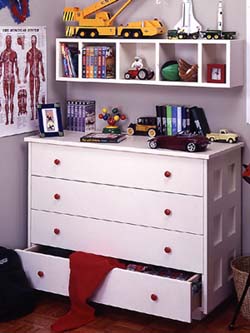| DRESSER |
| Keep the clothes off the floor
with our easy-to-build dresser. |
| TEXT AND PHOTOS BY NEAL
BARRETT |
|
 |

|
While it may seem that some kids can go indefinitely
wearing the same T-shirt and pair of jeans, most have an
appetite for clothes that can strain the most ample
budgets. And where do you put it all?
Well, before you decide to build an addition on the
house, take a close look at our solution. Designed to
match the rest of our bedroom suite, this dresser
features four generous drawers that slide effortlessly
on ball-bearing-equipped tracks, and sturdy plywood
construction with solid poplar detailing.
Best of all, the dresser is easy to build. The case
joinery utilizes a combination of joining plates and
screws–the plates ensure perfect joint alignment while
the screws provide holding power and eliminate the need
for glue and a lot of long clamps. We've also
streamlined drawer construction by employing simple and
fast glue-and-nail joints.
As shown in the photo (right), we've accessorized our
dresser with a wall-mounted storage unit. This piece is
based on the shelf assembly featured with our desk (see
"Stay Tuned"). To build the wall-mounted unit, follow
the instructions given for the desk unit, but eliminate
the leg sections and cut the end panels to 10 1/2 in.
long. | |
 |
 |
|
Case Construction
Equip your circular saw with a fine-tooth blade to
cut the plywood case parts to size. For accuracy, use a
straightedge guide positioned at the appropriate
distance from your cutline. With the guide square to the
edge of the panel, hold the saw base against the guide
while moving the saw slowly forward.
Use a household iron to apply veneer tape to the
front edges of the plywood case sides, bottom and front
cleat (Photo 1). Set the iron to its highest
setting, and advance it slowly while you press down
firmly. Position the 1 3/16-in.-wide tape so there's a
slight overhang on each side of the panel. |  |
 |
| 1--Heat the
hot-melt adhesive on the back of the veneer tape with an
iron. Slowly advance the iron with firm
pressure. | |
 |
 |
|
Use glue and 6d finish nails to assemble the toe kick
base. Lay the cabinet on its back, and clamp the base to
the case bottom while you bore pilot holes and screw the
toe kick in place (Photo 18).
Set all nailheads and fill the holes with wood
filler. Sand the case and drawer parts, finishing with
180-grit paper, and clean away the dust. Apply a good
latex primer to all cabinet surfaces and drawer faces.
If you wish to finish the drawer boxes, use two coats of
shellac.
When the primer is dry, lightly sand all surfaces
with 180-grit paper. Then dust it off before painting.
Apply two coats of a quality latex semigloss enamel,
following the directions supplied by the manufacturer.
When the paint is dry, reinstall the drawers.
MATERIALS LIST–Dresser
|
| Key |
No. |
Size and description (use) |
| A |
2 |
3/4 x 18 1/8 x 32 5/8" plywood
(side) |
| B |
1 |
3/4 x 18 1/8 x 43 1/2" plywood
(bottom) |
| C |
2 |
3/4 x 4 1/2 x 43 1/2" plywood
(cleat) |
| D |
2 |
3/4 x 3 1/2 x 25 5/8" poplar
(mullion) |
| E |
8 |
3/4 x 3 1/2 x 4 3/8" poplar
(short rail) |
| F |
4 |
3/4 x 3 1/2 x 12 1/4" poplar
(rail) |
| G |
4 |
3/4 x 3 1/2 x 32 5/8" poplar
(stile) |
| H |
1 |
3/4 x 19 1/4 x 46 1/2" plywood
(top) |
| I |
1 |
3/4 x 7/8 x 48" poplar
(edge) |
| J |
2 |
3/4 x 7/8 x 19 1/4" poplar
(edge) |
| K |
8 |
3/4 x 6 3/4 x 18" poplar
(drawer side) |
| L |
4 |
3/4 x 6 3/4 x 41" poplar
(drawer front) |
| M |
4 |
3/4 x 6 1/8 x 41" poplar
(drawer back) |
| N |
4 |
1/4 x 17 1/2 x 41 1/2" plywood
(drawer bottom) |
| O |
4 |
3/4 x 8 x 44 3/4" poplar
(drawer face) |
| P |
1 |
1/4 x 32 5/8 x 45" plywood
(back) |
| Q |
2 |
3/4 x 2 3/4 x 43" poplar (toe
kick face) |
| R |
2 |
3/4 x 2 3/4 x 16" poplar (toe
kick side) |
| S |
3 |
3/4 x 4 x 16" plywood
(cleat) |
| T* |
4 |
18" drawer tracks (Accuride
No. 3037-18") |
| U** |
8 |
1 1/4"-dia. knob (Hafele No.
13893100) |
Misc: No. 20 joining
plates; 2" No. 8 fh woodscrews; 1 1/4" No. 8 fh
woodscrews; 3/4" No. 6 rh woodscrews; 6d finish
nails; 1" brads; birch veneer tape; glue;
sandpaper; latex primer and enamel.
Notes: All
plywood birch veneer; dimensions include veneer
tape where applicable. *Available from Rockler
Woodworking and Hardware, 4365 Willow Dr., Medina,
MN 55340 (stock No. 32821) ** Hafele America Co.,
3901 Cheyenne Dr., P.O. Box 4000, Archdale, NC
27263 | | |
 |
| 18--After
assembling the toe kick pieces with glue and nails,
clamp the base to the dresser, bore screwholes and drive
screws. | |
 |
| |